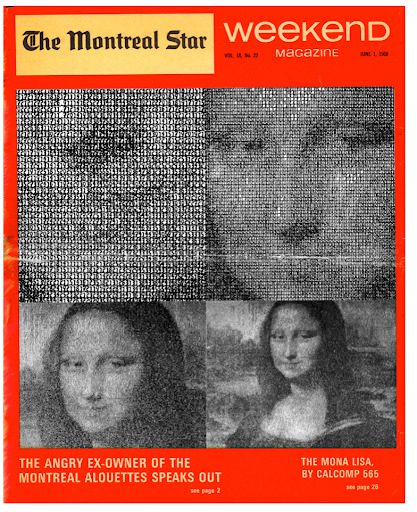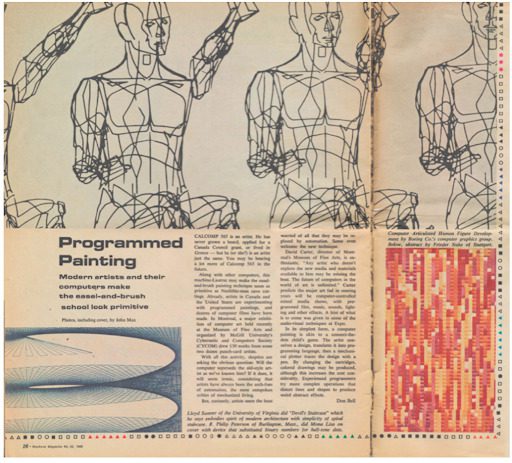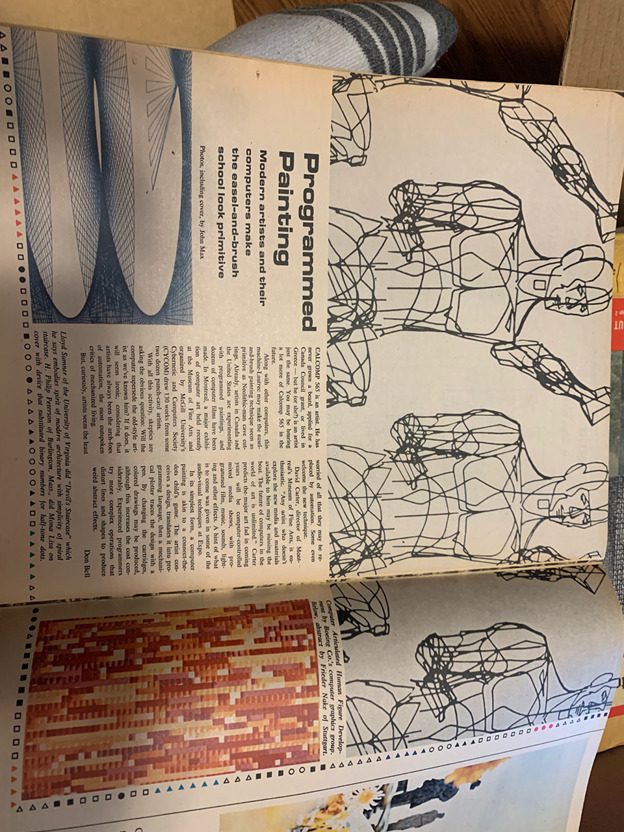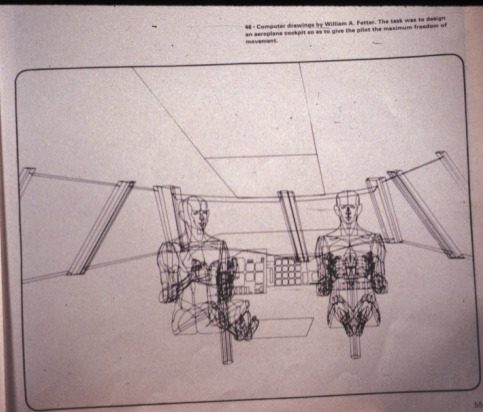Rene Pardo analyzes the Parallel of Computer Art in the 1960’s and Artists, NFT’s Today.
In the 60s everyone was approaching computer art from a scientific or mathematical point of view – such as using algorithms, transformations, and morphing techniques.
The Mona Lisa was digitized, recreated from its actual physical painting. Phil Peterson at Control Data created the “Digital” Mona Lisa, whereby characters were transmitted via satellite from the original Mona Lisa at the Louvre in Paris; 100 characters were overlaid over each other, per point, and a digital black and white version of the painting was printed on the plotter.
My friend Remy Landau and I organized the world’s first International Computer Art Exhibition in 1967.

Sponsored by the National Film Board and Junior Association of Montreal Museum (“JAMM”) held at the Montreal Museum of Fine Arts, included works from Ken Knowlton (including a digitized mural of Birds in Flight) Bell Labs (NJ), Lloyd Sumner (Virginia), Frieder Nake (Germany), Leslie Mezei (University of Toronto) from Boeing (Washington) – their “Ergonomic man” for designing their cockpits in the most optimum way based on the ergonomics of a human body.



Lloyd Sumner was both an artist and a computer programmer designing computer art using mathematical algorithms.
Fast forward today from the 1960s when you had collaboration between the computer programmer to the artists experimenting in the NFT space today!
You once again have artists learning about the technology, in this case now, about blockchain, how to mint NFTs and working with computer programmers to develop smart contracts so they can sell their art.
You have a parallel collaboration structure between artist and computer tech or software.
It will evolve to being the same individual having both skills, facilitated by software tools enabling individuals to express their creation – And evolution of tools and the evolution of the education of people learning each other’s skills and art. It’s exciting to watch the parallel between the 60s and today in that space. Software tools like blender, unreal engine, unity, 3D Generation of images, automated algorithms.
It’s really evolved from what was available to me in the 60s. Some people criticize the use of algorithms to generate 10,000 images, “Is it really art?” – not realizing that the very genesis of computer art began with algorithms generating beautiful images!
THE METAVERSE – A new medium “Dreaming while awake”
In projecting where technology will go, appreciating the core characteristics and strategic differentiations of each medium is really important.
I grew up influenced by Marshall Mcluhan’s “The medium is a message – understanding media”.
Each medium is unique – whether it’s a tweet broadcasting up to 280 characters (and images); whether it’s instant messaging such as when Blackberry came out such that people keyboard and transmit messages to each other silently in a boardroom meeting – silently communicating individual thoughts, without voice interfering and everyone hearing the communication. Interactive messaging versus sending messages that a person can read and respond to at their leisure. Other interactions require instant response to maintain social etiquette. Every medium has its characteristics. A few tech experts misread the Internet, referring to it as an “information highway,” rather than a “communications medium” with information as a subset.
It was obvious to me in the mid-nineties, that the Internet was a medium of communications, bringing people together across common interest groups, internationally.
The power of communications: if you go back to 1997 John McAfee had a company Tribal Voice which had developed a chat application called Powwow – most beautiful chat interface in contrast with the discord platform that comparatively has a difficult user interface to learn.
I discovered that some chatters had no money for food, they depended on food stamps. Yet they would pay $25 a month to AOL to get the diskette to be able to access the Internet because of the power of communications they could meet people who might take them out of poverty.
The priority and power of communications over food boggled my mind.
Now as we explore the concept of the metaverse, it’s too easy to fall into the trap of incremental innovation by incremental improvements – or taking what exists and applying it to the word “metaverse.”
Once again, one needs to understand the possibilities the medium creates, its uniqueness.
For me, the potential of the word “metaverse” is really, once again, communication.
For example, my mother who’s 99 is in a wheelchair in a long-term care home. She’s
restricted physically. However, when she dozes off and dreams she is free of cognitive and physical limitations. A dream is a very real experience.
I always say that we live in our minds, maybe up to 80% of the time. Clearly, the notion of mindfulness is to live in the present.
Dreaming brings a different beautiful reality to us. In my mother’s dreams she may think of her parents who died 50 years ago, and of my father who died 16 years ago. When she wakes up from dozing off she might say to a PSW or nurse that she just had dinner with her parents. Without appreciating the reality of the dream my mother experienced, they might incorrectly look at her and say she must have dementia, how crazy she is to not know her parents aren’t alive.
The truth is that the dream was real, free of physical limitations, free of her wheelchair.
For me the metaverse represents the opportunity to create environments where you can experience “dreaming while awake.” So, if we can create environments where people can live in those environments free of the physical or cognitive limitations, free of the wheelchair – interacting with others – again communications – interacting with other people where that interaction is as real as a dream is when asleep – but can be real while awake without the physical and cognitive limitations.
10-15 years from now, we will be able to interact with people who are no longer alive – whose thoughts, opinions have been captured, with input from others who knew them.
For example, I would be able to ask Norman McLaren in a metaverse what he thought of a particular film. People who knew him could enhance the answers, live in real time, based on knowing how he might have responded. We should be able to create an environment where you can communicate with people who are alive while multitasking, or people who are no longer alive where we have information about their thinking processes. The metaverse can be more than games and shopping.
The metaverse will bring freedom from physical and cognitive limitations.
Revealing who you are: Branding will be disrupted as the traditional beliefs regarding one representation requiring consistency over time (often through repetition) fights with the desire for a multiplicity of personalities that are desired to be revealed in different environments. Going in with a profile picture of your Bored Ape in a community of high wealth individuals is more desired than gaming fighting attacker cartoon. Much like specialty channels and audience market niches evolved from cable television.
The Metaverse is going to be an environment where you can be many people depending on what environment and community you go into. If socializing with “wealthy” people, one might show off their Bored apes.
The creation of a new “rolodex”, new communities of “communities,” “tribes” – people trusting to build relationships with people having common qualities, common interests.
If you’re going into a business environment you’ll select a profile picture representative of your brand, your image. People may be able to look into your digital wallet and based on NFTs you’ve purchased, to develop an impression. It’s a whole new environment which will have technical tools, suitable to a whole new medium.
You can experience physical freedom just like when you dream. I dream of my mother and my father regularly. My mother is free of her wheelchair and my father is alive. He’s talking with me and I’m talking with him; she’s walking around.
The Metaverse will not just be a place to shop, play games and/or chat. It will be a dream space. A place to experience interactions in those spaces less restricted by physical and cognitive limitations, while we’re awake.


































